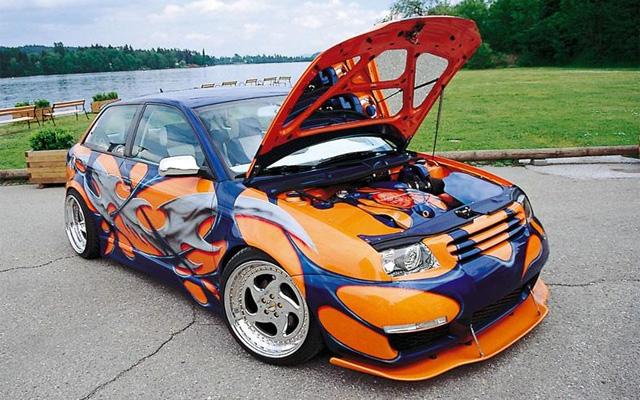Understanding Car Tuning
Car tuning refers to the process of modifying a vehicle to enhance its performance, aesthetics, and overall driving experience. This modification can encompass several aspects, including engine efficiency, suspension setup, and body styling. The primary objective of car tuning is to improve a vehicle’s capability and responsiveness while ensuring that it retains its original characteristics. Through tuning, an owner can truly express their individuality, allowing the car to reflect personal style and driving preferences.
There are various types of car tuning techniques available, each serving distinct purposes. Engine tuning, for instance, focuses on adjustments made to the engine for optimizing power output and fuel efficiency. It often involves reprogramming the vehicle’s electronic control unit (ECU) to enhance various parameters, such as air-fuel mixture and ignition timing. On the other hand, suspension tuning targets improving handling and ride quality, which can redefine how the car interacts with the road. Adjusting shock absorbers, springs, and sway bars can lead to a significant transformation in a vehicle’s dynamics.
Performance tuning, while accentuating speed and agility, must be balanced with the necessity to maintain the vehicle’s core characteristics. Over-tuning can lead to adverse effects, such as increased wear on components or compromise in drivability and comfort. Therefore, achieving a harmonious balance during the tuning process is crucial. Enthusiasts must ensure that modifications cater to their drives, whether they prioritize highway speed, track performance, or daily commuting comfort.
Ultimately, car tuning presents an opportunity for enthusiasts to delve deeper into their vehicles. By engaging in this purposeful modification, they can cultivate a tailored driving experience that resonates with their personal preferences, offering both enhanced performance and an embodiment of automotive artistry.
Evaluating Your Vehicle’s Unique Character
Understanding and evaluating your vehicle’s unique character is a crucial first step in the tuning process. Each car comes with factory specifications that define its performance and capabilities, which serve as the foundation for any modifications you may wish to undertake. These specifications typically include engine type, horsepower, torque ratings, weight distribution, and braking systems. Familiarizing yourself with these attributes will help you identify areas where enhancements may be beneficial and what kind of tunings align with your specific goals.
Next, assessing your driving habits is paramount. Consider how you primarily use your vehicle—whether it’s for daily commuting, spirited weekend drives, or competitive racing. This information will be instrumental in determining which aspects of your car merit enhancement. For instance, if your focus is on improved acceleration for daily city driving, you may prioritize tuning options that boost low-end torque. Conversely, if you have a penchant for track day outings, suspension upgrades and precise steering feedback might take precedence. Understanding your driving style allows you to tune your vehicle in a manner that reflects your personality and overall driving experience.
Additionally, personal preferences play a significant role in evaluating your vehicle’s character. Tuning is often an expression of individuality, and recognizing your own aesthetic and performance desires can help shape the modifications you choose. Do you prefer a comfortable ride or a more aggressive setup? Are enhanced aesthetics, such as body kits or custom paint jobs, equally important to you as performance upgrades? Identifying these preferences will ensure that your tuning efforts not only improve performance but also resonate with your personal taste.
In summary, by thoroughly evaluating your vehicle’s unique character through its factory specifications, your driving habits, and personal preferences, you can make informed decisions that align your tuning efforts with your vision and driving style.
Selecting the Right Tuning Approach
Tuning a vehicle is an intricate process that can enhance performance, efficiency, and aesthetics. However, selecting the appropriate tuning approach requires careful consideration of various factors including the car’s core character and the owner’s specific goals. Three notable tuning approaches are software tuning, hardware upgrades, and aesthetic modifications, each with its own advantages and disadvantages.
Software tuning, often referred to as ECU remapping, allows for adjustments to the engine’s performance parameters through digital programming. This method can yield significant gains in horsepower and torque while maintaining the integrity of the car’s performance characteristics. It is typically less invasive than hardware changes and can be reverted if necessary, which aids in preserving the manufacturer’s warranty. However, one downside is that the tuner’s expertise greatly impacts the outcome; improper tuning may lead to potential engine issues.
On the other hand, hardware upgrades involve physical modifications to the vehicle’s components, such as installing a high-performance exhaust or upgraded turbochargers. While these changes can provide substantial performance benefits, they are usually more involved and costly. Furthermore, hardware upgrades may alter the vehicle’s character more dramatically than software tuning, potentially making the car less practical for everyday use. It is essential, therefore, to ensure any modifications align with the intended driving experience.
Aesthetic modifications, such as new paint jobs or rims, focus primarily on the visual appeal of the car. Such modifications can enhance the vehicle’s presence on the road without impacting its mechanical performance. Nonetheless, these changes should complement the vehicle’s character rather than detract from it. Ultimately, the choice of tuning approach depends on the owner’s objectives – whether they prioritize enhanced performance, improved aesthetics, or simply a unique driving experience that reflects personal taste.
Implementing Tuning Strategies Without Compromise
Effective implementation of tuning strategies is a nuanced process that requires careful consideration of various elements. The first and foremost aspect to address is the significance of professional assistance. Engaging with experienced tuners ensures that the modifications applied are not only appropriate for the specific make and model of the vehicle but also executed with precision. Professional tuners possess the expertise to navigate the complexities inherent in tuning processes, thereby reducing the likelihood of errors that could adversely affect vehicle performance.
Compatibility of parts is another critical factor in successful tuning. Each vehicle comes with its own set of dynamic attributes, and thus, the components selected for tuning must harmoniously integrate with one another. This compatibility ensures that the modifications do not create conflicts within the car’s systems, which could lead to inefficiency or even damage. Utilizing high-quality aftermarket parts that are designed and tested to work seamlessly with existing components enhances not only the performance but also the longevity of the vehicle.
Once the tuning modifications are implemented, rigorous testing is essential to assess the outcomes of these changes. After completing the tuning process, it is imperative to conduct a series of performance evaluations that will allow the driver to gauge the effectiveness of the tuning. This testing phase will reveal whether the desired performance metrics have been achieved and if any adjustments are necessary. Moreover, maintaining a robust feedback loop during this phase contributes to fine-tuning the modifications, ensuring that both the inherent qualities of the vehicle and the performance enhancements are preserved in equilibrium.
In conclusion, the implementation of tuning strategies should be an informed and systematic approach that balances performance enhancement with the preservation of a vehicle’s character. By collaborating with professionals, ensuring parts compatibility, and rigorously testing results, drivers can truly enhance their connection with their vehicles without compromise.


No responses yet